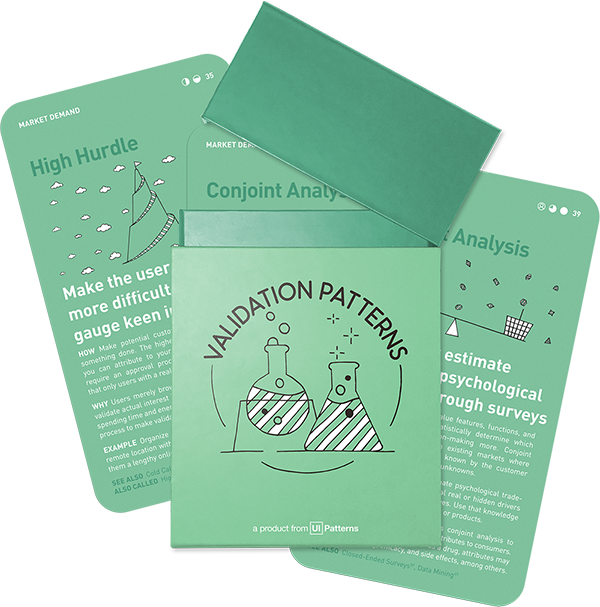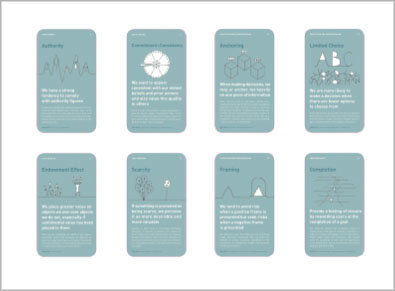Idea Validation: Market demand, Willingness to pay
Sales Pitch
Present the sales pitch of your product to a potential customer

How: Describe exactly what your product is going to do by pitching it to potential customers. At the end of the pitch, 'validate' your idea by asking: 'So would that solve your problem?'
Why: Understanding an abstract concept just explained is hard, telling if it can solve an actual problem is harder, and telling whether you would honestly pay money for the solution is near impossible. You can't ask customers to predict their own future needs. In terms of validating, customers need to show their interest through actions, not through telling it. Beware of false positive results.
What is the Sales Pitch product experiment?
This method involves presenting a product’s value proposition to potential users or customers to gather feedback on a problem and test the viability of a solution. The core objective is to determine if the target market perceives enough value in the solution to pay for it.
The sales pitch, as a smoke test, is fundamentally a learning process. It compels the entrepreneur to engage directly with potential customers, encouraging them to make a decision. This decision, whether positive or negative, provides valuable insights into the market’s reception of the product. In a B2C (Business-to-Consumer) context, this can involve testing aspects like ad copy, product packaging, and overall value proposition. In a B2B (Business-to-Business) setting, the approach might be more tailored, addressing specific needs of a company or a niche market. The success of these initial sales is a testament to the product’s appeal and relevance to the prospective customer.
The commitment of time and resources for this type of smoke test can vary greatly. It largely depends on factors such as the product’s cost and the chosen method of distribution. For low-cost products, the focus might be more on determining the best sales channels and might result in impulsive buying decisions by consumers. Conversely, high-value products, particularly in the B2B sector, can involve prolonged sales cycles, requiring multiple meetings with different decision-makers. These sales are not just financial decisions but can significantly impact the careers of those making the purchase decisions.
When a sales pitch is not product validation
When you as an entrepreneur excitedly describe exactly what problems your magic wand of a product will help customers solve, it often ends with the potential customers eyes dropping as they are about to fall asleep. Once you are done explaining everything that your product can do, it is wrong to assume that asking “Would that solve your problem” will be anywhere near product validation.
Even though the potential customers you dragged through your pitch would probably agree to anything just to get you to stop, this is still the worst thing you can do if validation is your goal.
It is practically impossible for anybody to tell you whether an abstract concept only explained in words will help solve a problem they have. Even if they could understand your abstractions, they would have no way of honestly providing you with an answer whether they would be willing to pay money for your fictitional product.
People can’t predict what they will do in the future. People are generally bad at predicting what they want, but good at reacting to things that already exist.
From the point in time where you present your abstract fictitional solution to customers, their minds are forever polluted by your idea. From that point on, they can only answer your questions from your perspective, not their own. That is the perspective of the solution you proposed.
Turn your pitch into customer discovery
Instead, turn your pitch into a customer discovery interview. Ask potential customers about how they are solving their problems today and only in the very end of the interview present your potential solution, briefly.
After the pitch, it’s common to face objections. How these objections are handled can provide deep insights into the prospect’s perception of the offer. Listening closely, understanding the concerns, and exploring the underlying reasons for any objections are crucial steps. If appropriate, these concerns should be repeated back to the prospect to ensure clear understanding. The ultimate goal is to close the sale, which can involve various strategies like offering discounts, highlighting exclusive features, or simply confirming the product’s ability to solve the prospect’s problem.
The results of this smoke test are quite telling. If the product or idea is sold successfully, especially for the first time, it indicates that the product has a market. This success is a validation of the business model and the ability to acquire customers, even if the product isn’t fully developed or delivering on all its promises yet. However, it’s important to note that this test doesn’t necessarily suggest the optimal price point or confirm the product’s profitability after considering all costs.
Don’t let biases get you
There are potential biases to be aware of in this approach. The anchoring bias can lead to over-reliance on a single sale as a proof of a viable business model. The clustering illusion might cause an entrepreneur to overgeneralize the learnings from a few sales. There’s also the risk of underestimating the time and effort needed to secure the first sale (estimation fallacy) and the curse of knowledge, where the entrepreneur’s familiarity with the product might overwhelm or confuse potential customers.
Real life Sales Pitch examples
Minivid
To test market demand, Minivid presented their sales pitch to potential customers. They adapted their strategy based on feedback, shifting from a user-focused widget to agency-style work and eventually to partnering with creative agencies. This approach helped them align their product with market needs and validate demand effectively.
Source: Minivid iteration case study
A collection of 60 product experiments that will validate your idea in a matter of days, not months. They are regularly used by product builders at companies like Google, Facebook, Dropbox, and Amazon.
Get your deck!Related plays
- UX for Lean Startups by Laura Klein by Laura Klein
- The Real Startup book - Sales Pitch Smoke Test by Tristan Kromer, et. al.

